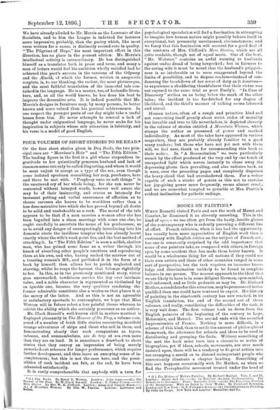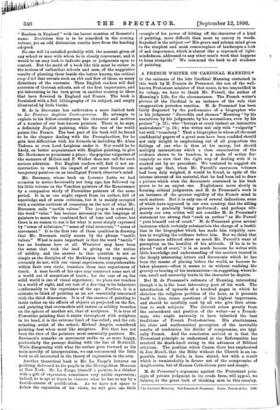BOOKS ON PAINTING.*
WHEN Rossetti visited Paris and saw the work of Manet and Courbet, he dismissed it as slovenly scrawling. This is the kind of apercu we too often get from the hasty, hostile glance of the contemporary who is ardently pursuing a different line of effort. French criticism, when it has had the opportunity, has usually been more appreciative of English work than is customary with English critics on the subject of French art ; but one is constantly surprised by the odd importance that some of our painters take, as compared with others, in foreign eyes, by some accident that has made them better known. It would be a wholesome thing for all nations if they could see their own artists and those of other countries ranged in some sort of perspective, but the task requires an immense know- ledge and discrimination unlikely to be found in complete balance in one person. The nearest approach to the ideal that we are likely to have is in some diligent German, open-minded, well-informed, and as little pedantic as may be. Dr. Richard Mather, a candidate for this situation, may be pronounced better qualified than one could have ventured to expect. His history of painting in the nineteenth century has now reached, in its English translation, the end of the second out of three volumes, and really, considering the difficulties of the task, it is very well done. The first volume took us down from the English painters of the beginning of the century to Ler, Meissonier, and Menzel. The second ends with the so-called Impressionists of France. Nothing is more difficult, in a scheme of this kind, than to settle the amount of philosophical framework, the allowance for schools and ideas to be used in distributing and grouping the facts. Without something of the sort the book must turn into a chronicle or series of biographies, yet if ideas, schools, movements, are over much insisted upon, there will be a tendency to fit great artists into too cramping a mould or to distend unimportant people who conveniently illustrate a chapter heading. Something of this sort happens occasionally with Dr. Mather, as when we find the Preraphaelite movement treated under the head of • (1) The History of Modern Painting. By Richard Mother. Vols. T. and II. London : Henry and Co.--(2.1 La Paint ore An jlaise Contemporains. Par Robert del, Sizeranne. Paris : Hachette et Cie —(3.) The Plorintine Pointers of the Renaissance. With an Index to :heir Works. By Bernhard Berenson. London and New York : G. P. Putnam's Sons.—(4) Consielerations on Painting.. By John La Forge. New York and London: Macmillan and Co.
Realism in England " with the barest mention of Rossetti's name. Doubtless this is to be remedied in the coming volume, yet an odd dislocation results here from the heading adopted.
No one will le satisfied probably with the account given of any school or man with whom he is closely conversant, and it would be an easy task to indicate gaps or judgments open to contest. But the merit of a book like this must be rather in the notices of unfamiliar schools and men, of the suggestive results of planting these beside the better known, the critical coup d'ceil that reveals such an ebb and flow of ideas, so many directions of the currents. Thus English readers will find accounts of German schools, not of the first importance, and yet interesting in the turn given in another country to ideas that have flowered in England and France. The book is furnished with a full bibliography of its subject, and amply illustrated by little blocks.
M. de la Sizeranne has undertaken a more limited task in La Peintara Anglaise Contemporaine. He attempts to explain to his fellow-countrymen the character and motives of a number of our best-known painters. There is, he says, a definitely English painting, while the rest of the world paints like France. The best part of his book will be found to be the chapter dealing with the Preraphaelites, for be gets into difficulties with his formula in including Mr. Alma Tadema or even Lord Leighton under it. Nor would he be likely, on better acquaintance with English painting, to give Mr. Herkomer so prominent a place ; the popular vulgariser of the manners of Millais and F. Walker does not call for such serious attention. But English readers will find it not un- instructive to watch the impact of our most famous con- temporary painters on an intelligent French observer's mind.
Mr. Berenson, whose book on Lorenzo Lotto we had occasion to notice favourably not long ago, has followed up his little volume on the Venetian painters of the Renaissance by a companion study of Florentine painters of the same period. It is, as one might expect from its author, full of knowledge and of acute criticism, but it is mainly occupied with a curious outburst of reasoning on the text of what Mr. Berenson calls " tactile values." The jargon is awkward; the word "value " has become necessary in the language of painters to mean the combined fact of tone and colour, but there is no reason to use it for what is more simply expressed by "sense of substance," " sense of vital structure," " sense of movement." It is the first two of these qualities in drawing that Mr. Berenson really means by the phrase "tactile values." What is more important is that the word "tactile" has no business here at all. Whatever may have been the sense that took the lead in giving us the notion of solidity, and the answer to that question is not so simple as the disciples of the Berkleyan theory suppose, we .certainly do not, with our visual experiences, comprehensible within their own circle, translate them into experiences of touch. A man bereft of his eyes may construct some sort of a. world out of sensations of touch ; for the rest of us, the solid world is one of visual experience ; we place our touches in a world of sight, and our test of a drawing is its behaviour -conformably to the experience of the eye. Further, it is a mistake to think of painting as an art essentially concerned with the third dimension. It is of the essence of painting to insist rather on the effects of objects as projected on the flat, and painting that overmodels and insists on solidity trenches on the sphere of another art, that of sculpture. It is true of Florentine painting that it exists throughout with sculpture in its head, it is the extreme limit of bas-relief ; and the cul- minating artist of the school, Michael Angelo, considered painting best when most like sculpture. But that has not been the view of the painters most essentially painters. Mr. Berenson's remarks on movement strike us as more happy, particularly the passage dealing with the line of Botticelli. While disagreeing with what the author puts forward as his main novelty of interpretation, we can recommend the little book to all interested in the theory of expression in the arts.
Another theoretical book is Mr. La Farge's lectures on - painting, delivered to his pupils in the Metropolitan Museum at New York. Mr. La. Farge, himself a painter, is a thinker with a gift of expression, sometimes very subtle expression ; indeed, he is apt at times to obscure what he has to say by a fastidiousness of qualification. As we have not space to follow the exposition of his views, we will give one little
example of his power of hitting off the character of a kind of painting, more difficult than most to convey in words. Ruysdael is the subject :—" His grave and solemn mind gives to the simplest and most commonplace of landscapes a look of sad importance, which is almost like a reproach of light- mindedness, addressed to any other man's work that happens to hang alongside." We commend the book to all students of painting.



































 Previous page
Previous page